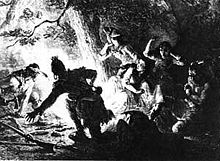Capture and rescue of Jemima Boone



The capture and rescue of Jemima Boone and the Callaway girls is a famous incident in the colonial history of Kentucky. Three girls were captured by a Cherokee-Shawnee raiding party on July 14, 1776, and rescued three days later by Daniel Boone and his party, celebrated for their success. The incident was portrayed in 19th-century literature and paintings: James Fenimore Cooper created a fictionalized version of the episode in his novel The Last of the Mohicans (1826) and Charles Ferdinand Wimar painted The Abduction of Boone's Daughter by the Indians (c. 1855).
History
[edit]After the outbreak of the American Revolutionary War in 1775, violence increased between Native Americans and settlers in Kentucky. American Indians, particularly Shawnee from north of the Ohio River, raided the Kentucky settlements, hoping to drive away the settlers, whom they regarded as trespassers. The Cherokee, led by Dragging Canoe, frequently attacked isolated settlers and hunters, convincing many to abandon Kentucky. This was part of a 20-year Cherokee resistance to pioneer settlement. By the late spring of 1776, fewer than 200 Americans remained in Kentucky, primarily at the fortified settlements of Boonesborough, Harrodsburg, and Logan's Station in the southeastern part of the state.
On July 14, 1776, a raiding party caught three teenage girls from Boonesborough as they were floating in a canoe on the Kentucky River. They were Jemima, daughter of Daniel Boone, and Elizabeth and Frances, daughters of Colonel Richard Callaway. The Cherokee Hanging Maw led the raiders, two Cherokee and three Shawnee warriors. The girls' capture raised alarm and Boone organized a rescue party. Meanwhile, the captors hurried the girls north toward the Shawnee towns across the Ohio River. The girls attempted to mark their trail until threatened by the Indians.
The third morning, as the Indians were building a fire for breakfast, the rescuers came up. As one captor was shot, Jemima said, "That's daddy's!" (gun).[2] He was not immediately killed. Two of the wounded Native men later died. The captors retreated, leaving the girls to be taken home by the settlers.
Jemima married Flanders Callaway, who had been one of the rescuing party. Elizabeth Callaway married Samuel Henderson, and Frances married John Holder. The episode served to put the settlers in the Kentucky wilderness on guard and prevented their straying beyond the fort. Although the rescuers had feared the girls would be raped or otherwise abused, Jemima Boone said, "The Indians were kind to us, as much so as they well could have been, or their circumstances permitted."[3]
Representation in media
[edit]- The incident is notable for inspiring the chase scene in James Fenimore Cooper's The Last of the Mohicans (1826), in which Lieutenant-Colonel George Munro, the book's protagonist Hawkeye (Natty Bumppo), his adopted Mohican older brother Chingachgook, Chingachgook's son Uncas, and David Gamut follow and overtake the Huron party of Magua who had taken as captives the sisters Cora and Alice Munro.
- The incident was also portrayed in 19th-century historical paintings for its dramatic clash of two cultures. Charles Ferdinand Wimar painted The Abduction of Boone's Daughter by the Indians (c. 1855).
- The rescue was featured as an illustration in William A. Crafts, Pioneers in the Settlement of America (1877).[4]
References
[edit]- ^ Illustration from William A. Crafts, Pioneers in the Settlement of America, Boston: 1877
- ^ Blackmon, Richard D. Dark and Bloody Ground. Yardley, PA: Westholme Publishing, 2012. According to Blackmon (p. 60), "Not heeding Boone's instructions for them all to gather before attacking the Indians, one of the pursuers fired. He was quickly followed by Boone and one other in their party. With at least two of the captors wounded, the Indians only had time to fling one tomahawk in the direction of the girls before all fled the scene. Hanging Maw had gone to the stream for water and evidently fled the area also. Jemima Boone, upon hearing the report of her father's rifle, exclaimed, "That's daddy's!" and the three girls began to run in the direction from where the report came. Once safe, the pursuers and the rescued girls returned to Boonesborough without incident." Blackmon cites this paragraph as being based on "Interview notes of Mrs. David Musick, 1868, Draper MSS, 22S185."
- ^ Faragher, John Mack (1992). Daniel Boone : the life and legend of an American pioneer (1st ed.). New York: Holt. p. 140. ISBN 978-0805016031.
- ^ William A. Crafts, Pioneers in the Settlement of America, Boston, 1877
Further reading
[edit]- Draper, Lyman. The Life of Daniel Boone, edited by Ted Franklin Belue. Mechanicsburg, PA: Stackpole Books, 1998.
- Pearl, Matthew (2021). The Taking of Jemima Boone: Colonial Settlers, Tribal Nations, and the Kidnap that Shaped America. HarperCollinsPublishers. ISBN 978-0-06-293778-0. OCLC 1269074402.
- Flavell, Julie (Oct 5, 2021). "What the Kidnapping of Daniel Boone's Daughter Tells Us About Life on the Frontier". New York Times. (Review of the book of Matthew Pearl).
